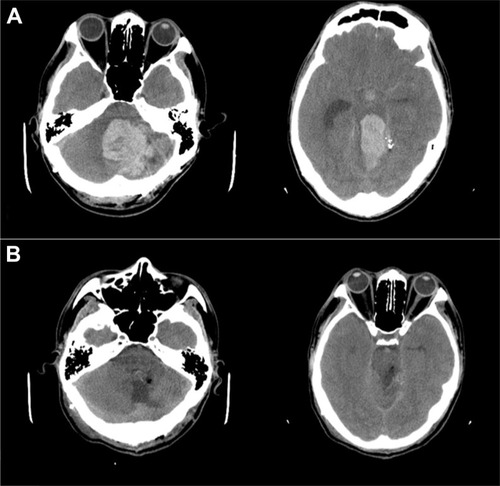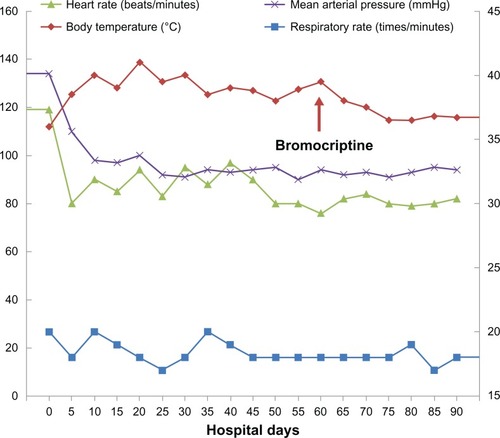Abstract
Central hyperthermia is characterized by a rapid onset, high temperature, marked temperature fluctuation, and poor response to antipyretics and antibiotics. Although poststroke central hyperthermia is common, prolonged instances are rare. We report a case of prolonged central fever after an intracranial hemorrhage. Before the accurate diagnosis and management of central fever, the patient underwent long-term antibiotic use that led to pseudomembranous colitis. Bromocriptine was used to treat the prolonged central hyperthermia, after which the fever did not exceed 39°C. A week later, the body temperature baseline was reduced to 37°C and a low-grade fever with minor temperature fluctuation occurred only a few times. No fever occurred in the month following the treatment. After the fever subsided, the patient could undergo an aggressive rehabilitation program.
Introduction
Fever is a frequent complication of stroke and is associated with worsened prognosis.Citation1,Citation2 Fever is likewise generally associated with infection because stroke patients are susceptible to various complications, such as aspiration pneumonia, urinary tract infection, or atelectasis.Citation3,Citation4 Most fevers that occur with stroke are caused by infections. Fevers without documented infection (probably that of central origin or “central hyperthermia”) were determined in 33% of stroke patients in a prospective study.Citation5 Fevers from a central origin and those caused by infection have completely different treatment strategies, and thus proper identification is important.
Central hyperthermia is characterized by a rapid onset, high temperature, marked temperature fluctuation, and higher mortality.Citation5,Citation6 Intracerebral hemorrhage, especially in the brainstem, is more predisposed in central fevers than in cerebral infarction. Most stroke patients with central fever had an increased temperature of 39°C within 1 day.Citation7 However, central fever is not persistent, and abated within 96 hours in 90% of stroke patients. Central fever rarely occurs during the subacute stage of stroke.Citation7 Antipyretics have no effect on central hyperthermia.Citation8
In this paper, we present a case of a patient who suffered from prolonged central fever after an intracranial hemorrhage that involved cerebellar, putaminal, and brainstem hemorrhagic stroke. The fever was difficult to control until bromocriptine was administered.
Case report
The 44-year-old male patient had good health before the onset of stroke. He did not have a past history of autoimmune disease or hepatitis, nor of recent travel. The patient was sent to the nearest emergency department of a community hospital because of dizziness and nausea with occasional vomiting. He was noted to be initially alert, but then his mental status rapidly declined.
The patient underwent rapid sequence intubation, and was transferred to the emergency department of the medical center. His blood pressure was 170/117 mmHg. Left pupil dilatation (6 mm) without light reflex was noted. The head computed tomography scan showed a large acute hematoma in the left cerebellum (48 mm × 46 mm) ruptured into the fourth ventricle, which caused an intraventricular hemorrhage, and another acute hematoma in the pons and midbrain (20 mm × 20 mm) (). An emergency bilateral suboccipital craniectomy was performed for hematoma removal. Intraventricular hemorrhage with external ventricular drain insertion was likewise performed (). One week later, the external ventricular drain was converted to the ventriculoperitoneal shunt. The patient underwent tracheostomy due to extubation failure. When the patient’s condition stabilized, he was transferred to the regular ward. Consciousness improvement was noted using the Glasgow Coma Scale from E1VtM1 to E4VtM5; however, intermittent fever had also been noted since his admission (). Temperature was characterized by a spike fever with marked fluctuations ranging from 37°C to 41°C. The neurosurgeon prescribed Unasyn® (ampicillin and sulbactam; Pfizer, Inc, New York, NY, USA) empirically for 2 weeks. The antibiotics were changed to Tazocin® (piperacillin and tazobactam; Pfizer, Inc) because Pseudomonas was found in one set of the sputum culture. The antibiotics were then changed to Tienam® (imipenem and cilastatin; Merck and Co, Inc, Whitehouse Station, NJ, USA) because the intermittent high fever remained.
Figure 1 CT findings of the brain. (A) Left cerebellar hemorrhage and brainstem hemorrhage with IVH shown in the preoperational CT. (B) Encephalomalacia change in the left cerebellum and midbrain (30 days after the emergent operation).

Figure 2 High fever with marked temperature fluctuation was noted during the clinical course.

The fever persisted despite the full course of antibiotic treatment and normal white blood cell count, C-reactive protein, erythrocyte sedimentation rate, and negative blood cultures. The patient was then transferred to the rehabilitation ward. A complete fever workup was performed, but no definite infection source was found. The autoimmune profile blood test, including tests for antinuclear antibodies and rheumatoid factors, were negative. Tumor markers, including carcinoembryonic antigen, alpha-fetoprotein, and carbohydrate antigen 19-9, were likewise negative. Electroencephalograms showed no epileptic activity. Given the long-term use of antibiotics, we checked the stool toxin for Clostridium difficile and obtained a positive result. Pseudomembranous colitis was diagnosed and the patient received a full course of metronidazole. However, the fever with marked temperature fluctuations and poor response to antipyretics was still noted.
An inflammation scan was arranged to determine any infection or inflammation, which may have been the cause of the fluctuating high fever. No occult infections were revealed. Physical cooling, including sponging, using a wet towel, and removing clothing, were employed to reduce the temperature, but hyperthermia reoccurred when the physical cooling procedure ceased. Under the impression of central hyperthermia, bromocriptine 2.5 mg/day was prescribed for 3 days and then increased to 5 mg/day. In the following week, the fever did not exceed 39°C. Another week later, the body temperature baseline was reduced to 37°C, and low-grade fever with minor temperature fluctuations occurred only occasionally (). The patient was discharged to the nursing home, and a follow-up 1 month later revealed no occurrence of fever.
shows the fever pattern, impression/diagnosis, and management during the clinical course. After solving the fever problem, improved endurance and motivation were noted, and the patient was able to undergo more aggressive rehabilitation programs.
Table 1 The fever pattern, impression/diagnosis, and management during the clinical course
Discussion
Fever occurs in 23% of stroke patients, and a third of these were documented without infection.Citation5 Central hyperthermia remains as an exclusion diagnosis. In these cases, even negative culture results may not definitively rule out infection. Thus, not every febrile patient without documented infection has central hyperthermia.
Either the locations of stroke (supratentorial or infratentorial) and types of stroke (hemorrhagic or ischemic) may cause an elevation in body temperature on the first day of stroke.Citation9,Citation10 Although poststroke central hyperthermia is common, prolonged cases are rare. Central hyperthermia exceeding 39°C abated within 4 days for approximately 90% of patients.Citation7
Differentiating central hyperthermia from an infection with fever is important because their treatments completely differ. In the present case, the diagnosis of central hyperthermia was delayed for several weeks, and the long-term use of antibiotics led to pseudomembranous colitis. Such a result was previously reported.Citation11
Hyperthermia is detrimental to the recovery of an injured brain, and the duration of fever is associated with poor outcome.Citation6,Citation12 Therefore, the timely and accurate diagnosis of central hyperthermia is crucial and could prevent unnecessary antibiotic use. The characteristics of central hyperthermia include a rapid onset (76% of patients developed a fever of 39°C within 12 hours after the stroke), high temperature, marked temperature fluctuation, and poor response to antipyretics and antibiotics.
Central hyperthermia treatment is based on physical cooling. Pharmacological management of prolonged central hyperthermia is difficult to study due to high mortality and poor prognosis. Baclofen was successfully used to abolish the prolonged central hyperthermia in a case report.Citation13 However, baclofen has side effects such as drowsiness, tiredness, and muscle weakness on the affected or unaffected limbs.Citation14 These side effects may interfere with the rehabilitation program. Some medications have been reported to lower the body temperature after a traumatic brain injury by regulating the sympathetic activity.Citation15 In another case report, a patient with traumatic brain injury and high fever of 40.5°C without documented infection received bromocriptine (0.025 mg/kg twice daily and gradually increased to 0.05 mg/kg thrice daily). A comparison of the mean daily temperatures before and after the bromocriptine prescription revealed the significant lowering of body temperature (P = 0.003). The patient was slowly weaned from bromocriptine over the next 5 weeks.Citation16
Bromocriptine is a dopamine agonist and acts at the level of the hypothalamus and corpus striatum.Citation17 The hypothalamus regulates central autonomic activity and has numerous connections with other parts of the central nervous system.Citation18 Hypothalamus dysfunction could lead to wide fluctuations in the core body temperature,Citation19 and therefore bromocriptine could also be used to control central hyperthermia.Citation16,Citation17 Stroke could be associated with autonomic dysfunction, and hemorrhagic stroke is more common than ischemic stroke.Citation20,Citation21 Based on these reports, we selected bromocriptine to treat prolonged central hyperthermia without the side effects of baclofen, such as general weakness and lethargy. After the fever subsided, the patient could undergo an aggressive rehabilitation program.
Conclusion
This report describes a case of prolonged central hyperthermia managed with bromocriptine. Central hyperthermia should be considered as a possible diagnosis for a stroke patient with fever to prevent unnecessary antibiotic use. Bromocriptine may also be an effective treatment for central hyperthermia.
Disclosure
The authors report no conflicts of interest in this work. No commercial party having a direct financial interest in the results of the research supporting this article has or will confer a benefit upon the authors or upon any organization with which the authors are associated.
References
- AzzimondiGBasseinLNoninoFFever in acute stroke worsens prognosis. A prospective studyStroke19952611204020437482646
- CastilloJDávalosAMarrugatJNoyaMTiming for fever-related brain damage in acute ischemic strokeStroke19982912245524609836750
- GeorgilisKPlomaritoglouADafniUBassiakosYVemmosKAetiology of fever in patients with acute strokeJ Intern Med1999246220320910447789
- RothEJLovellLHarveyRLHeinemannAWSemikPDiazSIncidence of and risk factors for medical complications during stroke rehabilitationStroke200132252352911157192
- Morales-OrtizAJiménez-PascualMPérez-VicenteJAMonge-ArguilesABautista-PradosJFever of central origin during strokeRev Neurol200132121111111411562838
- SchwarzSHäfnerKAschoffASchwabSIncidence and prognostic significance of fever following intracerebral hemorrhageNeurology200054235436110668696
- SungCYLeeTHChuNSCentral hyperthermia in acute strokeEur Neurol2009622869219521083
- ShibataMHyperthermia in brain hemorrhageMed Hypotheses19985031851909578322
- BoysenGChristensenHStroke severity determines body temperature in acute strokeStroke200132241341711157175
- LeiraRRodríguez-YáñezMCastellanosMHyperthermia is a surrogate marker of inflammation-mediated cause of brain damage in acute ischaemic strokeJ Intern Med2006260434334916961671
- MoudgalVSobelJDClostridium difficile colitis: a reviewHosp Pract (Minneap)2012401139148
- ReithJJørgensenHSPedersenPMBody temperature in acute stroke: relation to stroke severity, infarct size, mortality, and outcomeLancet199634789994224258618482
- HuangYSHsiaoMCLeeMHuangYCLeeJDBaclofen successfully abolished prolonged central hyperthermia in a patient with basilar artery occlusionActa Neurol Taiwan200918211812219673364
- HulmeABaclofen in the elderly stroke patient its side-effects and pharmacokineticsEur J Clin Pharmacol19852944674693912190
- LemkeDMSympathetic storming after severe traumatic brain injuryCrit Care Nurse20072713037 quiz 38.17244857
- RussoRNO’FlahertySBromocriptine for the management of autonomic dysfunction after severe traumatic brain injuryJ Paediatr Child Health200036328328510849235
- KangSHKimMJShinIYParkDWSohnJWYoonYKBromocriptine for control of hyperthermia in a patient with mixed autonomic hyperactivity after neurosurgery: a case reportJ Korean Med Sci201227896596822876068
- CarmelPWVegetative dysfunctions of the hypothalamusActa Neurochir (Wien)1985751–41131213993447
- Ordu GokkayaNKDaylan ArasMOkenOKoseogluFFever during post-acute rehabilitation in patients with brain injuryJ Rehabil Med200537212312515788348
- XiongLLeungHHChenXYComprehensive assessment for autonomic dysfunction in different phases after ischemic strokeInt J Stroke Epub July 3, 2012.
- PerkesIBaguleyIJNottMTMenonDKA review of paroxysmal sympathetic hyperactivity after acquired brain injuryAnn Neurol201068212613520695005